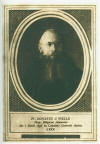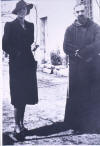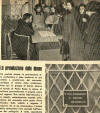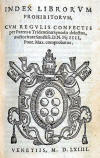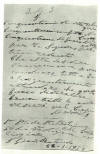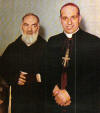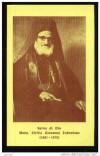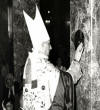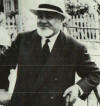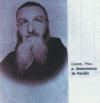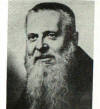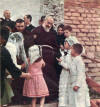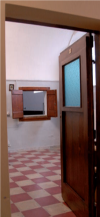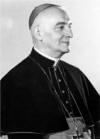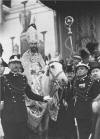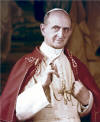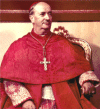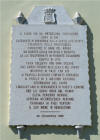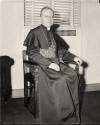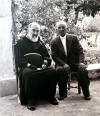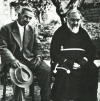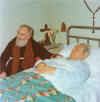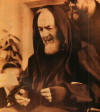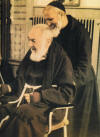25 Full Ministry, investigations, restrictions, last years.
Summary: Full ministry, investigations, restrictions, last years.
"Casa Sollievo della Sofferenza" Home for the relief of suffering
Drs. Mario Sanvico's and Sanguinetti home, where the first meeting took place.
January 9, 1940. First meeting for the hospital “Casa Sollievo”.[1]
[2]
Pius XII
On September 4, 1940, Pope Pius XII, observing that humanity was
steadily dividing itself into two ranks, exhorted the world to “Pray,
pray, pray. Prayer is the key to the treasure of God; it is the weapon
of battle and victory in the fight for good against evil.”[3]
Padre Pio stated promptly to dr. Sanguinetti: “Let’s roll our sleeves
and respond to the call of the Roman Pontiff.”[4]
The “Prayer Groups” were thus born.[5]
Padre Donato
August 7-15, 1941 canonical visit of Padre Donato da Welle, superior
general of Capuchin order. He reported in his testimony: “I have been
profoundly impressed by the way that Padre Pio practices the virtues.”[6]
Maria Jose’
On April 12, 1942 princess Maria Jose’ visited the friars in the convent and Padre Pio.[7]
American GIs
On January 6, 1945 Padre Pio celebrated a High Mass, sung by American
soldiers, as reported in the Chronicle of the convent.
[8]
Pia Pennelli
After his wife’s death, Padre Pio’s brother Michele moved to San
Giovanni Rotondo with his daughter Pia. She, in a ceremony attended by
many American servicemen, was married in May 1945, with her uncle
officiating, to Mario Pennelli, a teacher. Pia and Mario were to raise a
family of eight children, which Padre Pio considered an ideal size for a
family. He used to tell newlywed couples: “May you have eight children.”
[9]
Padre Pio himself was the fourth of eight children.
[10]
Michele Forgione died at the home of Mary Pyle, assisted by Padre Pio,
on May 9, 1967, at the age of 85.
[11][12]
Zi’ Grazio
On October 7, 1946 Padre Pio’s father dies, at the home of Mary Pyle,
comforted by his son.[13]
Casa Sollievo
May 19, 1947: Lying of the first stone and steady work begins for the
construction of the Casa Sollievo della Sofferenza “Home for the Relief
of suffering”.
Holy Family
July 6, 1947 opens the Capuchin convent in Pietrelcina, financed by the
American heiress Mary Pyle.[14]
Reservations
January 7, 1950 starts “reservation” for confession of women.
Casa Sollievo
In 1951 the construction of the imposing Casa Sollievo was going strong.
Money was not a problem. The offerings were pouring in from all over the
world. A new war started for the management of the Casa, possibly to
snatch it from the hands of Padre Pio.[15]
Pepe and Caronti
Holy Officès building
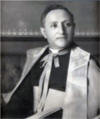 Mons. Giovanni Pepe
Mons. Giovanni Pepe
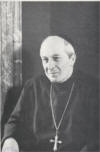
Abbot E. Caronti
 Abbot Caronti in 1946, Apostolic Visitor for the "Sons of the Divine
Providence" founded by St. Giovanni Orione
Abbot Caronti in 1946, Apostolic Visitor for the "Sons of the Divine
Providence" founded by St. Giovanni Orione
On December 31, 1951. Mons. Giovanni Pepe, and the Benedictine abbot
Emanuele Caronti were sent by the Holy Office to investigate.”[16]
[17]
Padre Angelo
On January 16, 1952 the
minister general of the Capuchin order, Padre Benigno da Sant’Ilario
Milanese, also sent Padre Angelo da Genova for an investigation.”[18]
[19]
Padre Benigno
On July 6, 1952 Padre Benigno went personally to San Giovanni Rotondo,
ordering to discourage pilgrimages to the convent, and to not diffuse
cards with the image of Padre Pio.[20]
Index
On July 30, 1952 the Holy Office emanated a decree where eight
publications about Padre Pio were put in the Index of Forbidden Books,
and on August 3, L’Osservatore Romano, explained that the publications
lacked the necessary ecclesiastical revision and approval.[21]
However, pope Pius XII had not been informed about it. When he was told
about it, the officer who had written the decree was fired, and the
decree was not implemented. At the same time the Holy Office received a
letter signed by Mons. Angelo Dell’Acqua, from the secretary of state of
the pope, stating the Padre Pio “had to be left undisturbed, to exercise
his priestly ministry.”[22]
50th anniversary
On January 22, 1953, Padre Pio celebrated the fiftieth anniversary of his entrance in the Capuchin order. The community of friars assembled in the refectory and from there led Padre Pio in procession to the church, singing Psalm 121 “Laetatus sum”.
At the altar, Padre Antonino da Sant’Elia a Pianisi, provincial
superior, delivered a short address, and received the renewal of the
votes from Padre Pio. Padre Pio then celebrated a solemn high Mass. In
the afternoon there was a thanksgiving service, were the famous tenor
Beniamino Gigli also sung.
Handwritten prayer card by Padre Pio for his 50th anniversary
Padre Pio wrote for his souvenir prayer card:
“Fifty years of religious life, fifty years nailed to the cross, fifty
years of devouring fire: for you, o Lord, for your redeemed. My soul
nothing else desires than bringing all of them to you and patiently wait
that this devouring fire burns all myself in the desire of dying.”[23]
Prayer card
Social activity
During the pontificate of Pius XII Padre Pio had the needed freedom to
implement important social initiatives.[24]
X-Rays
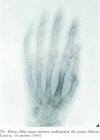 Palm left hand
Palm left hand
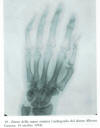 Back left hand
Back left hand
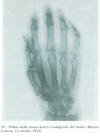 Palm right hand
Palm right hand
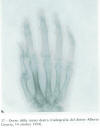 Back right hand
Back right hand
In 1954 Padre Pio had not been feeling well, with
respiratory problems. Prof. Francesco Lotti testified: “On October 13,
1954, with the superior of the convent Padre Carmelo da Sessano, we took
Padre Pio to the radiology department of Casa Sollievo to have an x-ray
of the head and chest done. By disposition of Padre Carmelo, and without
Padre Pio knowing it, we did also radiographs of hands and feet. I was
told by the radiologist that there was absolutely nothing abnormal at
the level of the metacarpal and metatarsal areas.”
(Gerardo, Le Stigmate 1985, 300-3)
(Ger85, Appendice fotografica, 17-21)
The radiologist was Dr. Alberto Caserta from Foggia. At that time the
hospital did not have the own equipment started yet, and Dr. Caserta
worked from his private office in Foggia.
Coop
In December 1955 opened the coop “Cooperativa San Francesco”, strongly
wanted by Padre Pio to allow the town’s folks to buy food and other
items at reasonable price.[25]
Grand Opening
May 5, 1956 grand opening of the Casa Sollievo della Sofferenza Home for
the relief of Suffering.
St. Mary of the Graces
Mons. Paolo Carta and Mons. Zohrabian
On July 2, 1956 Padre Pio blessed the cornerstone of the new church of
St. Mary of Graces. The new church was consecrated by Bishop Paolo Carta,
bishop of Foggia, and the Capuchin Mons. Cirillo Giovanni Zohrabian,
bishop of Acilisene, on July 1, 1959.[26]
Complex
On December 17, 1957 was opened in San Giovanni Rotondo a new
subdivision in Rione Santa Croce that included a church, a preschool,
and a vocational center for girls wanting to learn sewing and
embroidering. The complex was managed by Franciscan sisters. In
the same time frame, another preschool was opened in “Rione
Sant’Onofrio that Padre Pio dedicate to “San Francesco d’Assisi”. It was
managed by the Capuchin sisters of the Sacred Heart. An orphanage was
also opened in the area.[27]
Vocational center
On January 26, 1958 was inaugurated The Vocational Center “San Giuseppe
Artigiano”, for youngsters wanting to learn a trade.[28]
Ciccone and St. Francis hall
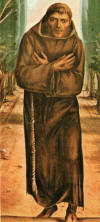
 St. Francis fresco by Antonio Ciccone.
St. Francis fresco by Antonio Ciccone.
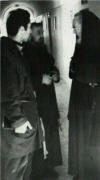
 Antonio conversing in the hallway, and praying with Padre Pio
Antonio conversing in the hallway, and praying with Padre Pio
In December 1958, Giuseppe Gentile, the architect of the new church of
Santa Maria delle Grazie commissioned a fresco depicting Saint Francis
to Antonio Ciccone. The location was a large space between the new
church and the hallway with the cells of the friars. Antonio started
working in the spring of 1959m and the fresco was completed on May 14,
1959. He lived in the convent during those months, and had the
possibility to be in contact with Padre Pio all day long.[29]
Antonio Ciccone was raised on the family farm on the Pataridde (Patariello)
area, behind the Capuchin convent in San Giovanni Rotondo.[30]
On July 1, 1959 took place the Consecration of the new church Santa Maria delle Grazie.
Mons. Zohrabian actually consecrating the new church
Giuffre’
Giambattista Giuffrè
In the sixties the very success of Casa Sollievo gave Padre Pio major
difficulties. The steady pouring of contributions became a source of
contention in the Capuchin Order.
The Capuchins had fallen prey of the pyramid scheme financier
Giambattista Giuffre’. The so called “God’s Banker’ gave interests from
30% to as high as 90%. The Capuchins, like many others, invested large
sums of money with Giuffre’. Padre Pio, who had the ultimate
administrative control over the funds, was approached by Capuchin
functionaries, and asked to invest. Padre Pio refused. In the summer of
1958 Giuffre’ declared bankruptcy. The Capuchins faced an economic
disaster.
They approached Padre Pio once again, and he once again refused to give
the money donated to “Casa Sollievo’. At that point a plan emerged to
take control of the hospital from Padre Pio, accusing him of being a
poor administrator, disobedient, and morally unfit.[31]
The plan included bugging the convent with tape recorders and
microphones, in order to get confidential financial information
especially from the administrator of Casa Sollievo Angelo Battisti, and
to document inappropriate behavior between Padre Pio and his spiritual
daughters.
[32]
Padre Bonaventura
Padre Bonaventura da Pavullo
In February 1960, Cardinal Ottaviani, secretary of the Holy Office, sent
Padre Bonaventura da Pavullo to investigate some rumors that had reached
the Holy Office. His report on April 13, 1960, was negative towards
Commendator “Angelo Battisti, administrator of Casa Sollievo”, and also
negative towards “three pious women having a damaging influence on Padre
Pio.”
[33] The report also said positive
words about Padre Pio “honest, simple delicate; doing a bundersome and
precious spiritual work.”[34]
Crovini
Mons. Mario Crovini (center)
On March 12, 1960 the Holy Office sent Mons. Mario Crovini “to talk to
Padre Pio, and ask if there are any inconveniences going on, and for his
suggestion on how to fix them.” Mons. Crovini went privately to San
Giovanni Rotondo On April 20, 1960, with the excuse of personal medical
tests to be done at Casa Sollievo. He stayed two days. He had long
conversations with Padre Pio. The friars had a hostile behavior towards
Mons. Crovini.[35]
[36]
Clemente
Padre Clemente da Milwaukee
On April 14, 1960 the superior general Padre Clemente da Milwaukee sent
a letter to the Pope asking for an Apostolic Visitation to fix “grave
problems with the administration of Casa Sollievo”, and also “spiritual
questions.”[37]
[38]
Padre Clemente: “Just like any other individual religious Padre Pio had
a vow of poverty. Pope Pius XII did not dispense Padre Pio from the wow
in general, But the Pope Pius XII said: “You can do everything with the
total income of Casa Sollievo.” Therefore Padre Pio was always under the
vow of poverty, and at the same time he could dispose of the hospital
funds and goods as he saw fit. The only suspension from the vow of
poverty pertained to the hospital Casa Sollievo.”[39]
Microphones
On May 11, 1960 the first microphone was installed on the internal
window separating the convent from the visitor’s room. The conversation
between Padre Pio and his spiritual daughter Cleonice Morcaldi was
recorded. Padre Giustino and fra Masseo, listening to the recording
thought to hear “tender expressions” and “a kiss”.
[40]
The Holy Office was informed, and the tape brought to the Vatican. The
tape was reheard in the Holy Office, and Padre Giustino was summoned to
the Holy Office “to better interpret the words pronounced in Neapolitan
dialect”.[41]
[42]
Padre Amedeo da San Giovanni Rotondo who heard the tape with don Terenzi
reported: “The voice recorded was so faint that I could catch only few
words, and never a complete sentence. And I paid attention but didn’t
hear any smacking of a kiss.”[43]
The newlywed bride Pia Pennelli gives a smacking kiss to the hand of her uncle Padre Pio
Smacking kisses of Padre Pio's hand
The famed neapolitan singer Furio Rendine kissing with a smack Padre Pio's hand in 1962
A girl who has just received the First Communion kisses with a smack the hand of Padre Pio
Carmelina Miglionico from San Giovanni Rotondo, giving a smacking kiss to Padre Pio's hand on her wedding day, June 28, 1962
The room of the convent with the window connecting to the non cloistered area
Mons. Crovini: “Whoever has seen the window between the two rooms
understands how impossible is to join cheeks and give kisses.”[44]
The other microphones were placed in Padre Pio’s cell, and also in the confessional. [45] [46] The placement in
the
confessional is denied by
some historians.[47]
Thirty six tapes were made during a three months period.
[48]
Padre Pio discovered himself a microphone under his bed, with the wire
passing through the wall of his cell, to the cell of Padre Giustino. He
cut the wire with a pocket knife.[49]
When Padre Pio discovered the wires he told it to his friend Francesco Morcaldi. Morcaldi leaked the story to the press.[50]
Padre Pio said to bishop Cesarano: “My own brethren are doing this to me.”[51]
Padre Paolino told a friend: “We are terrified by these events. We
cannot, however, deny the facts.”[52]
Mons. Crovini wrote a letter to the Pope about the microphones. John
XXIII ordered the apostolic visitor to have the removed immediately.”[53]
Donations
The dispute over the handling of the donations to “Casa Sollievo” continued, and there were complaints that the money was not handed over for the purpose designated by the donors.”[54]
There were also complaints of dissents among the friars, and ongoing
problems of fanatic disciples.[55]
Pope John XXIII decided to address the concerns by sending an Apostolic
Visitor.
Maccari
Mons. Maccari
On July 30, 1960 Mons. Maccari went to the convent accompanied by don
Giovanni Barberini.[56]
From the start he treated with arrogance the provincial superior Padre
Amedeo.[57]
He let people known that they had to “enter in order and silence” in the
church at 4:30 AM, to assist to Padre Pio’s Mass.[58]
He ordered that the reservations for the confessions be handled
exclusively by a friar.[59]
He also disposed that at confession time, only the women with a
reservation could enter and stay in the little church; that the two
churches be separated by an iron gate; that all the recording gear be
removed.[60]
The confessions had to last no more than three minutes, or the person
will be removed even before the absolution.
Concerning “Casa Sollievo” Mons Maccari appeared a bit biased, alleging
“illicit enrichment of some staffers,” without examining the books.[61]
Mons. Barberini, the secretary of Mons. Maccari, prohibited the
community from helping Padre Pio. He was denied help in going up and
down stairs. One day Padre Pio fell going down the narrow staircase
which joined the big choir to the small choir. He was left to pick
himself up as best as he could.[62]
50th anniversary
50th
August 10, 1960: 50th anniversary of Padre Pio’s ordination
to priesthood: sober celebration among many faithful.[63]
Maccari and Barberini had left the convent on August 6. They returned on
August 13, 1960.[64]
Padre Pio had expressed the desire that Padre Raffaele make the speech,
as he had done fifty years before. The wish was denied, and Padre Amedeo
did the talk. And there wasn’t the customary Apostolic Benediction.”[65]
Before leaving Maccari had given disposition that the anniversary be
celebrated with the very minimum of pomp.[66]
Gherardo Leone: “The celebration has been simple and spontaneous. It has
had two leading characters: Padre Pio and the crowds. Or better, only
one: Padre Pio surrounded, encircled, besieged by the enormous choral
mass of people.”[67]
Maccari made some proposals such as removing the fixed time of the Mass,
prohibit bishops and priests from serving the Mass, and keep a strict
discipline for the confessions; and gradually substituting all the
friars with friars from other provinces.[71]
On December 14, 1960, the Holy Office, fulfilling the recommendations by
Mons. Maccari, ordered that Padre Pio could not talk alone to women,
that a new provincial be named, and remove and substitute gradually all
the friars.[72]
Padre Paul-Pierre Philippe
Future Cardinal Mons. Paul-Pierre Philippe
On February 1, 1961, the Holy Office delegated one of his consultants
for a mission “top secret” to directly confront Padre Pio about “the
pending against him in the Holy Office. Padre Paul-Pierre Philippe, a
Dominican friar, talked to
Padre Pio on February 22, 1961.[73]
Confronted about the accusation of immorality, Padre Pio stated: “It is
not true. Absolutely not true. I never kissed a woman. I tell you in
front of the Lord that I never wanted to kiss my mother. I made her cry
because I did not return her kisses. I thought it was wrong.”[74]
Padre Philippe left the same day, and wrote in his report that he had
not been able to convince Padre Pio “of his wrong behavior and of the
need to change.”
[75]
He continued: “Padre Pio appeared to me as a man of limited
intelligence, very astute and obstinate; a smart peasant who has no will
to change. Padre Pio passed inadvertently from minor gesture of
affection to graver actions, up to the carnal act. And now, after so
many years of a sacrilegious life, maybe he doesn’t realize the gravity
of the wrongdoing. This is the story of all the fake mystics who fell to
erotism. Padre Pio is the most colossal fraud ever found in the history
of the Church.”
[76]
He recommended: “Suspension of confessions and Mass, and transfer as
soon possible to a faraway convent.”[77]
[78]
Cesarano
Mons. Andrea Cesarano enters Manfredonia in 1931
On April 18, 1961 Mons. Andrea Cesarano, bishop of Manfredonia, visited
Pope John XXIII. They were longtime friends. The Pope asked about “the
women, the recordings. They have even recorded kisses.”[79]
Mons. Cesarano:”Please, don Angelo, Padre Pio is an Apostle who does an
immense good for the souls. I know him since 1933. He is a saint. Those
kisses are not sinful. Let me explain.”
[80]
Mons. Cesarano reported that when his sister accompanied him to the
convent, she would grab Padre Pio’s hand and kiss it, and kiss it again,
and squeeze it, despite the complaint by Padre Pio that it was very
painful because of the wounds.[81]
Pope John raised his sight to heaven and said: “Glory to God.! You are
giving me a great comfort. What a relief.”[82]
Later the Pope stated: “On Padre Pio, they fooled me.”[83]
After John XXIIIs death, Eng. Pietro Gasparri confessed to Padre Pio
that he had thoughts that the Pope had persecuted Padre Pio. Padre Pio:
“Pope John XXIII went straight to Heaven.”[84]
Holy Office
On April 19, 1961 in a meeting of the Holy Office it was decided not to
accept the recommendations of Philippe, and to continue with the
restrictions of Maccari.[85]
Restrictions
In 1961-4 the restrictions imposed by the Holy Office on Padre Pio and
the convent continued to be strictly implemented by the superior of the
community Padre Rosario da Aliminusa.[86]
Rosary
On January 20, 1962. Because of poor sight the Office is commuted with
complete Rosary.
Montini
On June 3, 1963 Pope John XXIII died. The friars kept pestering Padre
Pio about the Conclave, until he said: “It’s going to be Montini. Now
will you be quiet?” On June 23, 1963 Montini was elected Pope Paul VI.[87]
In 1959 Card. Montini of Milan gave to Alberto Galletti a message for
Padre Pio, asking for particular prayers. Padre Pio told Alberto that he
promised fervent prayers, and also told Alberto to inform that he would
be elected pope, adding: “Do you understand what you are to tell him?
Tell him so because he must get ready.” Card. Montini was taken by
surprise, and told Alberto: “Oh! The strange notions of the saints!”[88]
[89]
Paul VI
Pope Paul VI
On June 21, 1963 the new
pope Paul VI was elected.
Padre Clemente was a consultant of the Holy Office and of the
Congregation for Religious. He reported: “Paul VI gave me this order:
“Liberate Padre Pio from those restrictions.” Then he said: “You of the
Holy Office leave Padre Pio free to confess. Don’t confine him like a
criminal.”[90]
Full freedom
Cardinal Alfredo Ottaviani
On January 30, 1964 cardinal Alfredo Ottaviani, secretary of the Holy
Office, conveyed to Padre Clemente da Santa Maria in Punta, apostolic
administrator of the capuchin province of Foggia, the disposition from
the new pope Paul VI: “The Holy Father wants that Padre Pio exercises
his ministry in full freedom. “Padre Clemente went to San Giovanni
Rotondo and removed all the restrictions imposed on Padre Pio by the
Holy Office.[91]
Condemnation
Holy Office
The condemnations of Padre Pio by the Holy Office have never been
revoked.[92]
Freedom
Padre Carmelo da S. Giovanni in Galdo
On December 16, 1964, Padre Pio signed a declaration
as requested by the superior, Padre Carmelo da San Giovanni in
Galdo: “For quite some time news have been published in the press on my
situation, as I was the object of persecution by the ecclesiastical
authority. In the presence of God I feel the need and the duty to
deplore those news as false, and to declare that I enjoy freedom in my
ministry and I don’t have enemies and persecutors. I can publicly affirm
that I find in the superiors of my Order, and in the authority of the
Church comprehension, comfort, and protection. And I don’t need other
defenders besides God and his legitimate representatives.”[93]
Obedience
On February 12, 1965 Cardinal Ottaviani, by disposition of Pope Paul VI,
told Padre Clemente da Santa Maria in Punta that “from now on the had to
deal with Padre Pio as he was not bound by the wow of obedience.” Thus
was totally eliminated any form of restriction.[94]
Vatican II
The Ecumenical Council Vatican II opened on October 11, 1962. It was
closed on December 8, 1965.During the Council several bishops went to
the convent and visited with Padre Pio.
Mass in Latin
Used by Padre Pio
On February 17, 1965 Padre Pio got a dispensation to continue to say
Mass in Latin.[95]
Dr. Sala
Dr. Giuseppe Sala
In 1965 Padre Pio was assigned dr. Giuseppe Sala as personal physician.[96]
50th
On July 28, 1966 the town celebrated the 50th anniversary of
Padre Pio’s move to San Giovanni Rotondo. A marble sign on the front
side of the church remembers the event. The town also issued a
commemorative coin in bronze, silver and gold.[97]
60th
Cardinal Amleto Cicognani
On Sunday January 26, 1967 Padre Pio celebrated the 60th
anniversary of the permanent wows. Pope Paul VI, through Cardinal
Cicognani congratulated Padre Pio and authorized him to give a special
blessing to the faithful.[98]
Sitting
November 21, 1966: may celebrate sitting in public.[99]
Padre Raffaele
From March 1966 through April 1967, by disposition of Padre Clemente da
Santa Maria in Punta, Padre Pio was submitted to formal interrogations
by Padre Raffaele da Sant’Elia a Pianisi. The six sessions regarded
mostly the events of the first invisible wounds in 1910.[100]
Michele Forgione
On May 9, 1967: Michele Forgione, Padre Pio’s brother dies at age 85. He
had been living in San Giovanni Rotondo at the home of his daughter Pia,
married to Mario Pennelli. Padre Pio comforted him.[101]
Prayer groups
On May 25, 1967, an immense crowd gathered to celebrate Padre Pio’s
birthday. There was also the International Convention of the prayer
groups. Padre Pio was ill and greeted the crowds from the window with
his famous oversized handkerchief.[102]
Confessions
In 1967, last full year of activity, Padre Pio confessed about 25
thousand people. That is an average of seventy people per day, as from
the book of reservations.[103]
Wheelchair
On March 29, 1968 Padre Pio starts using the wheelchair.[104]
Mary Pyle
April 26, 1968 Mary Pyle dies in Casa Sollievo.[105]
Anniversaries
May 25, was Padre Pio’s birthday. August 10, was the anniversary of his
ordination to priesthood. September 20, 1968 was celebrated the 50th
anniversary of (visible) wounds. Again immense crowds gathered to honor
Padre Pio.
[106]
Letter
On September 12, 1968 in a letter sent by Padre Pio to the Pope Paul VI:
"I offer to you my prayers and my daily suffering, so that the Lord
comfort you with his grace, to continue defending the eternal truth that
never changes with the times change. I thank you for the clear words in
the "Humanae Vitae" (The encyclical letter 'Of human lifè) and confirm
my faiths and my unconditional obedience."[107]
Stigmata
September 20, 1968: 50th
anniversary of (visible) wounds.
Convention
Sunday September 22, 1968, the last full day in the life of Padre Pio, started in San
Giovanni Rotondo the Fourth International Convention of the Prayer
Groups.
On Monday September 23, 1968 at 2:30 AM Padre Pio died.
Bibliography
Alessando, da Ripabottoni (Saint Pio of
Pietrelcina. Everybody's Cyrenean). 2010. San Giovanni Rotondo:
Edizioni Padre Pio.
Ale10
Campanella, S. (2011). Oboedientia and Pax. La vera storia di una
falsa persecuzione. San Giovanni Rotondo: Edizioni Padre Pio.
Cam11
Capuano, P. (2012). Con p. Pio: come in una fiaba. Foggia:
Grafiche Grilli.
Cap12
Flumeri, Gerardo (1995). Le stigmate di Padre Pio, Testimonianze e
relazioni. Edizioni Padre Pio.
Ger95
Flumeri, Gerardo da (1996). Positio super virtutibus Betifications et
Canonizationis servi Dei Pii a Pietrelcina. 6 thomes, synthesis of 104
volumes of diocesan process. Roma: Capuchin Order.
Positio
Fortuna, A. (1999). Antonio Cicconès Padre Pio. Florence: Latini.
For99
Giannuzzo, E. (2012). San Pio da Pietrelcina. Il travagliato persorso
della sua vita terrena. Book sprint edizioni.
Gia12
Ingoldsby, M. (1978). Padre Pio. His Life and Mission. Dublin:
Veritas Publications.
Ing78
Multiple. (2009). Padre Pio The wonder worker. New Bedord, MA:
Franciscan Friars of Immaculate.
Mul09
Napolitano, F. (1978). Padre Pio of Pietrelcina. A brief biography.
San Giovanni Rotondo: Edizioni Padre Pio.
Nap78
Padre, Pio da pietrelcina (2010). Have a good day. San Giovanni
Rotondo: Edizioni Padre Pio.
Pio10
Peroni, L. (2002). Padre Pio da Pietrelcina. Borla.
Per02
Pietrelcina, P. P. (2011). Epistolario I Corrispondenza con i
direttori spirituali (1910-1922). San Giovanni Rotondo: Edizioni
Padre Pio.
Epist. I
Pietrelcina, P. P. (2012). Epistolario IV, corrispondenza con diverse
categorie di persone. San Giovanni Rotondo: Edizioni Padre Pio.
Epist. IV
Rega, F. M. (2005). Padre Pio and America. Rockford: TAN books.
Reg05
Riese, Fernando da (2010). Padre Pio da Pietrelcina crocifisso senza
croce. San Giovanni Roronto: Edizioni Padre Pio.
Fer10
Ruffin, C. B. (1991). Padre Pio: the true story. Huntington,
Indiana: Our Sunday Visitor, Inc.
Ruf91
Schug, J. O. (1987). A Padre Pio Profile. Petersham, MA: St.
Bedès Publications.
Sch87
[1] Gia12, 315
[2] Per02, 403
[3] Ale10, 187
[4] Fer10, 396
[5] Gia12, 328-9
[6] Ger95, 128
[7] Gia12, 312
[8] Cap12, 22
[9] Ruf91, 270
[10] Ruf91, 26
[11] Pio10, 27
[12] Positio II/1, 789
[13] Cap12, 22
[14] Gia12, 327-8
[15] Gia12, 3330-1
[16] Nap78, 158-61
[17] Gia12, 333
[18] Nap78, 161
[19] Gia12, 333
[20] Gia12, 332
[21] Nap76, 161
[22] Gia12, 333
[23] Epist. I, 1032
[24] Gia12, 332
[25] Gia12, 334
[26] Gia12, 326-7
[27] Gia12, 334
[28] Gia12, 334
[29] For99, 31
[30] For99, 13-4
[31] Reg05, 235
[32] Gia12, 366
[33] Gia12, 366
[34] Cam11, 94
[35] Gia12, 367-70
[36] Cam11, 96
[37] Gia12, 367-8
[38] Cam11,101
[39] Sch87, 108
[40] Cam11,112
[41] Gia12, 371
[42] Cam11, 113
[43] Gia12, 371-4
[44] Cam11, 114
[45] Gia12, 373
[46] Per02, 497-8
[47] Cam11, 112
[48] Ruf91, 353
[49] Gia12, 385-6
[50] Ruf91, 353
[51] Ruf91, 353
[52] Ruf91, 353
[53] Cam11, 116
[54] Ruf91, 354
[55] Ruf91, 355
[56] Gia12, 382
[57] Cam11, 131-5
[58] Cam11, 142
[59] Cam11, 142
[60] Gia12, 385
[61] Gia12, 382-90
[62] Gal95, 174
[63] Gia12, 383
[64] Gia12, 383
[65] Cam11, 149-50
[66] Per02, 510
[67] Per02, 517
[68] Gia12, 390
[69] Gia10, 390-1
[70] Cam11, 152
[71] Gia10, 391
[72] Gia11, 392
[73] Cam11, 177
[74] Cam11, 178
[75] Cam11, 179
[76] Cam11, 179-80
[77] Cam11, 177-80
[78] Gia12, 194-5
[79] Cam11, 184
[80] Cam11, 184
[81] Cam11, 164
[82] Cam11, 185
[83] Cam11, 185
[84] Cam11, 226
[85] Gia12, 395-6
[86] Gia12, 400-1
[87] Sch87, 70
[88] Ing78, 95-6
[89] Mul99, 32
[90] Sch87, 107
[91] Gia12, 402
[92] Gia10, 045
[93] Gia12, 408
[94] Gia12, 409
[95] Gia12, 409
[96] Gia12, 409
[97] Gia12, 409-10
[98] Gia12, 409
[99] Gia12, 410
[100] Per02, 554-5
[101] Gia12, 412
[102] Gai12, 412
[103] Gia12, 412
[104] Gia12, 412
[105] Gia12, 412
[106] Gia12, 413
[107] Epist. IV, 12-4


